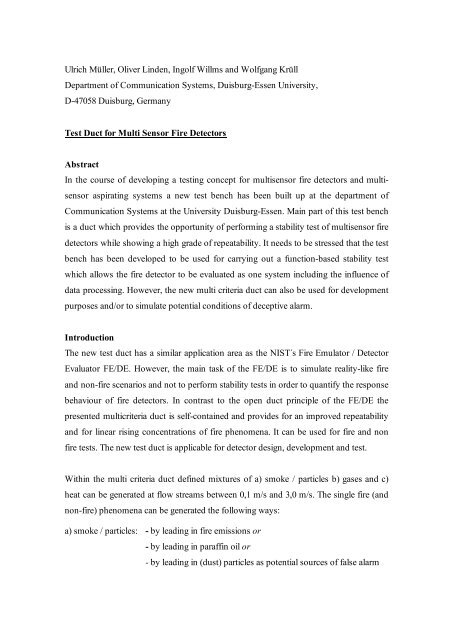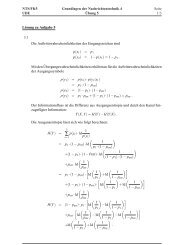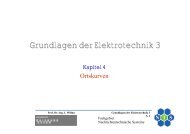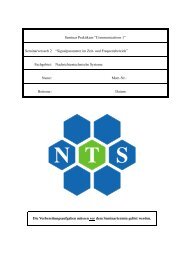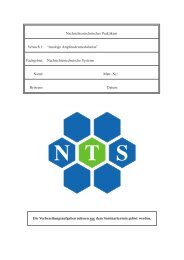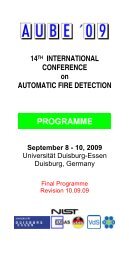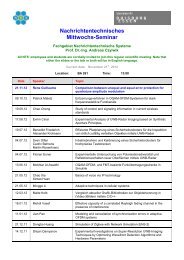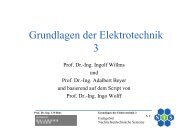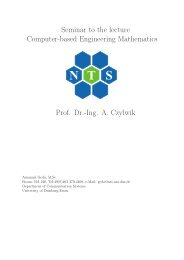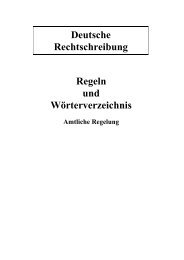pdf-File - Nachrichtentechnische Systeme, NTS
pdf-File - Nachrichtentechnische Systeme, NTS
pdf-File - Nachrichtentechnische Systeme, NTS
Create successful ePaper yourself
Turn your PDF publications into a flip-book with our unique Google optimized e-Paper software.
Ulrich Müller, Oliver Linden, Ingolf Willms and Wolfgang Krüll<br />
Department of Communication Systems, Duisburg-Essen University,<br />
D-47058 Duisburg, Germany<br />
Test Duct for Multi Sensor Fire Detectors<br />
Abstract<br />
In the course of developing a testing concept for multisensor fire detectors and multi-<br />
sensor aspirating systems a new test bench has been built up at the department of<br />
Communication Systems at the University Duisburg-Essen. Main part of this test bench<br />
is a duct which provides the opportunity of performing a stability test of multisensor fire<br />
detectors while showing a high grade of repeatability. It needs to be stressed that the test<br />
bench has been developed to be used for carrying out a function-based stability test<br />
which allows the fire detector to be evaluated as one system including the influence of<br />
data processing. However, the new multi criteria duct can also be used for development<br />
purposes and/or to simulate potential conditions of deceptive alarm.<br />
Introduction<br />
The new test duct has a similar application area as the NIST´s Fire Emulator / Detector<br />
Evaluator FE/DE. However, the main task of the FE/DE is to simulate reality-like fire<br />
and non-fire scenarios and not to perform stability tests in order to quantify the response<br />
behaviour of fire detectors. In contrast to the open duct principle of the FE/DE the<br />
presented multicriteria duct is self-contained and provides for an improved repeatability<br />
and for linear rising concentrations of fire phenomena. It can be used for fire and non<br />
fire tests. The new test duct is applicable for detector design, development and test.<br />
Within the multi criteria duct defined mixtures of a) smoke / particles b) gases and c)<br />
heat can be generated at flow streams between 0,1 m/s and 3,0 m/s. The single fire (and<br />
non-fire) phenomena can be generated the following ways:<br />
a) smoke / particles: - by leading in fire emissions or<br />
- by leading in paraffin oil or<br />
- by leading in (dust) particles as potential sources of false alarm
) gases: - by leading in fire emissions and/or<br />
- by leading in single gases or gas mixtures from gas cylinders<br />
optionally water vapour can be injected (if necessary)<br />
c) heat: - by heating up the duct material by means of heating cables and<br />
- by simultaneously leading in hot air to heat up the air in the duct<br />
This paper shall show the setup of the new test bench as well as results of repeatability<br />
measurements regarding smoke density, gas concentrations and temperature.<br />
Technical Background of implemented features<br />
For testing multi sensor fire detectors with gas sensors it is important that the<br />
combustion gas mixture is not changed by the test equipment to a greater extend. So the<br />
new test duct uses a low temperature heating concept due to the reason that zones of<br />
high temperature might promote chemical reactions among the gases. Furthermore, the<br />
presence of silicone compounds has a potentially poisoning effect on some gases which<br />
might result in a non-reversible change of the sensing properties. Another unwanted<br />
effect has been excluded or minimised by the use of teflon-coated stainless steel.<br />
However, the use of chemical elements like zinc or copper might promote chemical<br />
reactions with the combustion gases. In addition further positive effects are reached due<br />
to the choice of the duct material: the metal is protected against oxidation, the whole<br />
duct can easily be grounded and the danger of water condensation at the heated metal<br />
surface is almost excluded.<br />
The multi criteria duct is self-contained in order to reach a high grade of repeatability<br />
and almost linear rising concentrations of fire phenomena. A sheet metal of not more<br />
than 1 mm thickness is used to achieve a low heating time constant for the duct<br />
material. The maximum temperature rise of the duct (4 K/min) has been chosen with<br />
respect to the development of the moderate burning open test fire TF 1.<br />
The testing of heat detectors according to EN 54–5 is not realised yet. For this purpose<br />
the heating concept would have to be upgraded to achieve a temperature rise of 30<br />
K/min. However, this feature is not relevant for testing multi sensor fire detectors.
To achieve a homogeneous heating of the test duct the aerosol inside the duct and the<br />
duct material are heated up by different heaters. The whole surface of the duct is heated<br />
by 290 meters of heating cable, the inspection windows are heated by using heatable<br />
window panes. Currently the duct air is heated by means of a hot air blower. In the next<br />
time the blower will be replaced by a heater which will be mounted inside the duct. First<br />
experiments with the hot air blower have shown a bad influence on both linearity and<br />
repeatability of the rise of fire phenomena.<br />
Figure 1 visualises a simulation of the heating concept. The left curve of Figure 1 shows<br />
the temperature rise of the air at the measuring zone being produced by the hot air<br />
blower working at a flow-rate of V& = 200l/<br />
min and a temperature of T = 60 ° C . The<br />
temperature rise of the duct material is shown in the right curve of Figure 1. It is<br />
produced by 290 meters of heating cable being operated at P = 5500W<br />
.<br />
Figure 1: Simulated temperature of the duct air (left curve) and the duct<br />
material (right curve)
Figure 2: Setup of the test bench
The test bench setup<br />
The setup of the test bench is printed in Figure 2. The technical data of the test bench is<br />
given below. Up to date photos of the test duct are pictured in Figure 3 and in Figure 4.<br />
Technical data of the test duct:<br />
Function: Testing of fire detectors with smoke-, heat- and / or gas-sensors<br />
Temperature range: 20…60°C<br />
Wind velocity: 0,1…3,0 m/s<br />
Inserted substances: user-defined<br />
Temperature rise: 0…4 K/min<br />
Max. heat power: 8 kW<br />
Measurement : - smoke density: Transmitted light: MIREX<br />
Ionisation chamber: MIC<br />
- gas concentrations: Infrared photometry: Uras 14<br />
- temperature: PT 100<br />
Volume: 1200 l (Mean airway 7,5 m; Cross section 0,4 m x 0,4 m)<br />
Principle: self contained duct<br />
Figure 3: Test duct
Figure 4: Measurement equipment<br />
Results of repeatability measurements<br />
Particle density:<br />
A Lorenz AGW paraffin oil generator was used to produce a defined rise of particle<br />
density within the duct. For first evaluation studies the following parameters have been<br />
chosen:<br />
Frequency of the internal valve: 1.5 Hz<br />
Total flow rate: 50 l/min and<br />
Paraffin oil temperature: 100°C<br />
With these parameters the following rise of smoke density can be measured in duct:<br />
∆m<br />
dB<br />
≅ 0 . 07<br />
∆t<br />
m ⋅ min<br />
The gradient fulfils the specifications for testing smoke detectors according to EN 54-7:<br />
dB ∆m<br />
dB<br />
0 . 015 ≤ ≤ 0.<br />
1<br />
m ⋅ min ∆t<br />
m ⋅ min<br />
The measured data is graphed in the Figure 5 to Figure 7. The studies have been carried<br />
out without using the heating system.
Figure 5: Smoke density measurement with the MIREX<br />
Figure 5, Figure 6 and Figure 7 show a very high grade of repeatability. The rise of<br />
smoke density is almost linear. The repeatability factor for the MIC and the MIREX is<br />
1.<br />
04<br />
= 1.<br />
08.<br />
It describes the maximum factor of deviation regarding the highest and the<br />
0.<br />
96<br />
lowest value being measured at the same point of time.<br />
Figure 6: Smoke density measurement with the MIC
Figure 7: Plot of the function m = f(Y)<br />
Temperature rise:<br />
The temperature rise in the measurement zone shows the function of the heating system<br />
(Figure 8). Until the end of the test a temperature rise of ∆ T ≅ 27K<br />
was reached. The<br />
presented evaluation studies already show a high repeatability (repeatability factor:<br />
1. 04 ). However, currently no kind of heating control is implemented. A later<br />
implementation of a heating control is planned to obtain a high grade of flexibility for<br />
future investigations.<br />
Figure 8: Measurement of the temperature rise inside the test duct
Rise of gas concentrations:<br />
For generating combustion gases 3 cotton wicks have been burned down in the burning<br />
chamber which was provided with clean air at a constant flow rate of 42 l/min and a<br />
relative humidity of 50 %. The concentrations of carbon monoxide and carbon dioxide<br />
have been measured (see Figure 9 and Figure 10).<br />
Figure 9: Measurement of carbon monoxide concentration<br />
Figure 10: Measurement of the rise of carbon dioxide concentration
Former investigations at University Duisburg-Essen have already shown a high<br />
repeatability of gas concentrations being generated by cotton wicks being burned under<br />
defined conditions. According to the expectations also the current test results presented<br />
in the Figure 9 and Figure 10 show a low grade of deviation and a highly linear rate of<br />
rise. For both carbon monoxide and carbon dioxide a repeatability factor of 1. 06 was<br />
reached. The studies have been carried out without using the heating system.<br />
Conclusion<br />
The first evaluation studies which have been performed with the new multi criteria test<br />
duct have shown absolutely promising results. Both the rate of rise and the repeatability<br />
of the generated fire phenomena already meet the initial objectives at a very early stage.<br />
These objectives have been set up in order to perform a defined and repeatable stability<br />
test for multi sensor fire detectors. The repeatability factors which have been achieved<br />
regarding the rise of temperature, particle density and gas concentrations are smaller<br />
than 1.1. This is far below the permitted max. change of response behaviour (factor 1.6)<br />
a detector may show according to EN 54. However, additional tests need to be<br />
performed for final conclusions concerning all repeatability issues.<br />
In the future more automatic functions have to be integrated. Magnetic valves and the<br />
heating option shall be controlled by PC in order to allow fully automated testing.<br />
Furthermore, it is intended to implement a continuously adjustable temperature control<br />
(0…4 K/min) and a complex humidity measurement / control unit. Further work will<br />
also be done on the implementation of vapour and dust generators and tests concerning<br />
slowly developing fires. Beyond that the basic concept of the new duct shall serve as<br />
low-cost testing concept for multi sensor fire detectors by providing the opportunity to<br />
upgrade existing EN 54 - test benches with low financial efforts.
References<br />
/1/ O. Linden, Entwicklung von Prüfmethoden zur Sicherstellung der<br />
Schutzfunktion von Brandmeldern mit Gassensoren, Dissertation, Bergische<br />
Universität Wuppertal, February 2003<br />
/2/ U. Müller, Konzeption einer Prüfeinrichtung zur Bestimmung der<br />
Ansprechschwelle von Multisensor-Brandmeldern für Brand- und<br />
Nichtbrandsituationen, Diploma thesis, Universität Duisburg-Essen, December<br />
2003<br />
/3/ U. Müller et al., Design and functionality of a new test duct for multi sensor fire<br />
detectors, Proceedings of EUSAS-Workshop on “Multiple Sensor based (Fire-)<br />
Detectors; Design and Testing”, Lübeck/Germany, June 2004


